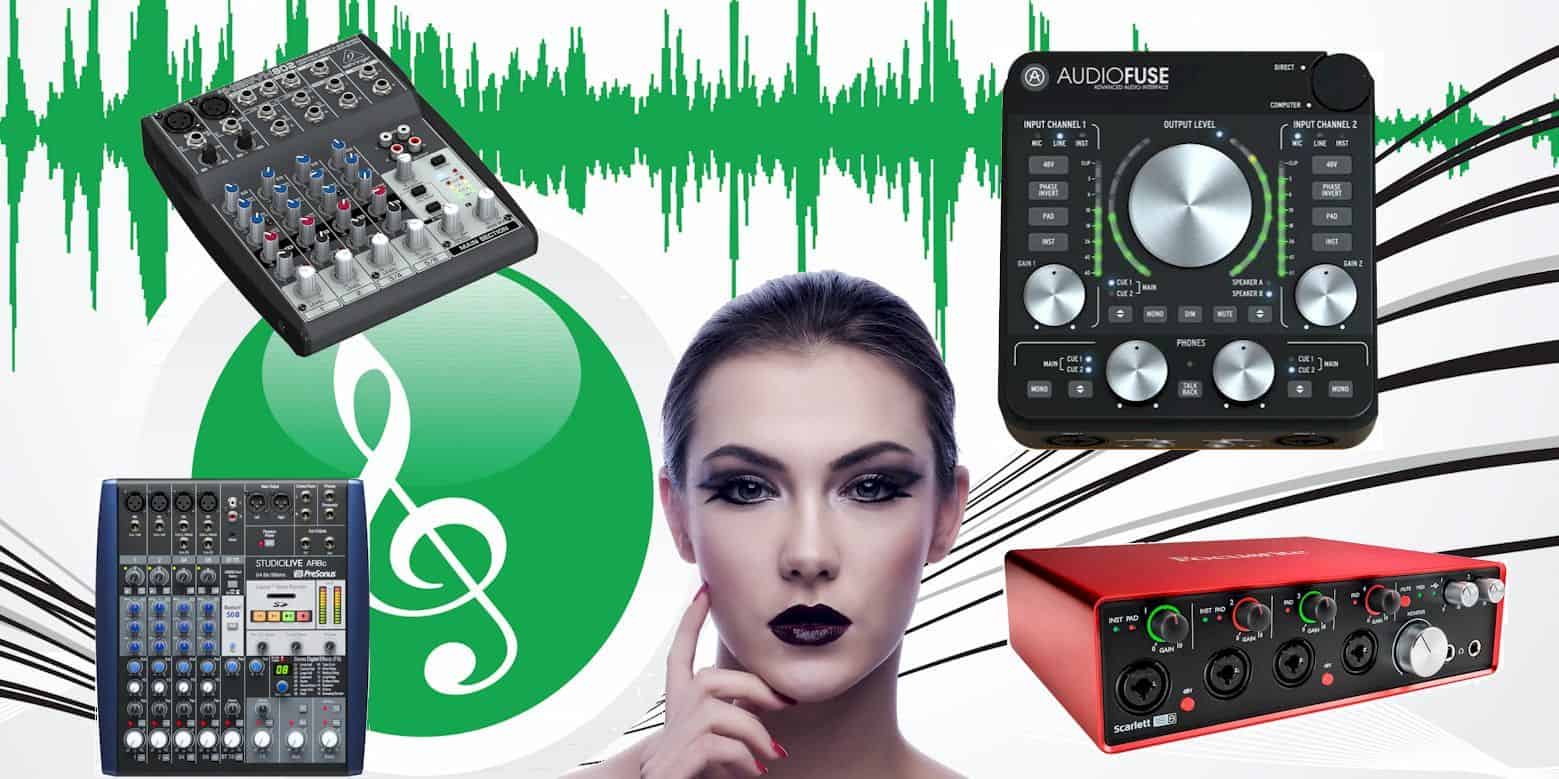Are you baffled about the distinction between mixer vs audio interface? Well, you are not the only person who feels uncertain about this equipment. Do you want to find the most efficient way of recording audio on your computer? Or perhaps you like to Livestream with excellent quality? Or maybe you want to do both?
Can you perform it with single studio equipment or do you require numerous items? What are the mixers and audio interfaces? These are some things that you may want to unveil. Later in this article, you will understand the distinction of mixer vs. audio interface. This will also lead you to understand which one is more suitable for you.
Contents
What is a Standalone Audio Interface?
You may like to read the comprehensive guide to audio interface.
Although a standalone audio interface is not created to resemble an analog audio mixer, nearly each audio interface features a mixing software that substantially provides you a mixer-like control through both your inputs and outputs. You should get that to initiate headphone mixes for the artists, to handle inputs and outputs, and other common tasks.
Other audio interfaces also exhibit inbuilt processing that lets you attach EQ, reverb, or compression to specific channels, once more from the mixing software. Several standalone audio interfaces grant you mixer-like control through your signals, and one just has to use a software control panel to perform it.
Whether it will come comfortable or not, it will all depend on you as well as your workflow. If you are a producer and you record vocal takes through DAW software, then using a different window to handle your audio chain can seem more adequate than it would for any streamer who is also attempting to supervise their capture card and at the same time streaming software.
Another thing to consider is the form factor. Standalone audio interface consumes minimal space as compared to mixers with in-built interfaces. Although they can be placed on the desktop, a standalone audio interface can be placed easily somewhere not accessible to view or in a rack. Hence, the standalone audio interface is more portable – something to think about if you intend to record outside the studio.
What is a Standalone Mixing Console?
If you like to record your mix on a PC through a standalone mixing console, you have to get the right and left outputs from a mixer and use the suitable audio cables to attach them to line inputs through an audio interface. Then, the audio interface produces a digital signal that is appropriate for Livestream or in DAW recording software.
Remember that you are about to record the stereo output of the integrated signals generated from the mixer. Hence, you cannot record on different tracks concurrently. However, you can record numerous audio sources simultaneously as a single stereo file. Moreover, rather than simply recording flat and unprocessed audio, tracks will develop impacts and EQ adapted through a mixer.
What is USB Mixer?
A USB mixer is a kind of box that features one or more USB ports that give the user the privilege to directly play and record audio into the computer. The mixer works by mixing numerous audio sources all at once, counterbalancing them, even putting various effects to make your preferred sounding audio track. The audio track is delivered back through a single stereo output.
A lot of mixers do not exhibit a manner of directly connecting to a computer via a USB. Nevertheless, a USB mixer is exceptional from this traditional perception of mixers and has gradually turned more usual inside both professional and home studios. Since the USB mixer delivers the recorded audio to the PC through a stereo output, that implies that the entire mixing and tailoring that you might like to be executed on the track should be performed live while recording since the individual tracks are no longer available for mixing the moment they are in the PC.
Related: about karaoke mixers
Differentiating Audio Interface vs Mixer for Different Usages
Podcasting
How do you compare podcast mixer vs audio interface? If you are podcasting and you are doing a live broadcast, then it would be more ideal to use a mixer since it can grant you that adaptability to easily alter things on the fly. However, if you are only recording your podcast and intend to proceed on editing it and put it together at a later time, then choosing an audio interface can be enough.
Related: An Audio Interface Focusrite Scarlett 6i6 Review
Streaming
The significant leverage of a mixer is that it is more suitable for streaming. It is quite better than the audio interface. This is because the audio interface will require you to depend on software to process the mixing of the audio before being able to stream.
You may already know that software can fail, and if you plan to stream a podcast on a live audience, you should avoid depending on it. By using a mixer, you can do the mixing of audio on the board and transmit it to the computer for streaming. This is quite safer and a lot better at executing things.
Recording
Which is better when recording vocals with a mixer vs audio interface? Audio interfaces cost lower because they do not provide features that are available in mixers. Choosing audio interfaces will commonly let you record a single track at a given time when doing the recording by yourself. Furthermore, when recording, you normally like to achieve the cleanest signal. This implies that applying compression, EQ, or any means of processing while in the way is normally not rational because you prefer to deal with the original audio track version in the DAW.
Related: How To Connect Powered Speakers To Mixers
Important Features to Consider when Buying an Audio Interface or a Mixer
Whether you choose to buy an audio interface or a mixer, there are some important features that you will want to check before making a decision:
Phantom power
If you like to use any kind of microphone, then you must ensure that your audio interface or mixer features phantom power. Although it is a common feature, certain interfaces only exhibit phantom power with one or two inputs. Prepare for the kind of microphones that you will be using and see to it that you will have available phantom power for any device that requires it. You can find external phantom-power, however, it is less convenient.
Inputs
With audio interfaces and mixers, you will commonly find efficient XLR inputs for mics. However, the line-level of both inputs and outputs can be on unbalanced RCA jacks, unbalanced TS jacks, or balanced TRS jacks. The outputs for the monitor speakers can provide any of these. What is essential to learn is that it is acceptable to use an adapter cable or adapter plug to make things operate as they should – in particular, to attach the 1/4-inch line-level outputs of the interface to the XLR line-level inputs on the studio monitors. Provided that you are complementing the microphone-level outputs to microphone-level inputs as well as the line-level outputs to the line-level inputs, it is okay to use adapters if you have to.
Stereo and mono channels
If you are checking on the number of channels that are offered by a mixer, it is typical for manufacturers to consolidate the inputs of mono and stereo. To wit, a mixer with 12 channels may only provide two mono channels with mic inputs and another five stereo channels having stereo line-level for every channel.
These inputs are practical for media players, drum machines, and keyboards. However, they are not useful for plugging in specific microphones. The most effective approach to discern what you can connect to a mixer or audio interface is to thoroughly check the front and rear panels to confirm what kind of connections you will have to deal with.
How it is operated
If you aim to achieve complete portability, then it will be best to buy an audio interface that can be operated through USB, getting rid of the requirement to connect to wall power. Several audio interfaces that feature bus power may also come with a power supply.
This gives you the advantage of using the device which, ever is practical at the current time. Even if you are not wandering the town and recording the entire day, you may love the comfort if you have to switch the location of your setup regularly.
Last Words
Although an ideal audio interface can give clear, ample, expert-level voice-over recordings, audio mixer grants you access to play with exceptional features and uncover what they are capable of doing to transform the recordings.
Choosing the appropriate equipment can be daunting, particularly because there are numerous choices available. When comparing a mixer vs audio interface and deciding which one to use, it would be best to go for a mid to first-class audio interface. It will help you begin with your recording with nominal trouble. Nonetheless, if you have prepared for an extra amount and you have enough time to examine, you may want to choose a mixer.

Graduated with a Bachelor of Audio Engineering and Sound Production. He has worked with a number of studios as a Recording Engineer, with over 10 years of servicing experience in both re-recording mixing and sound editing.

